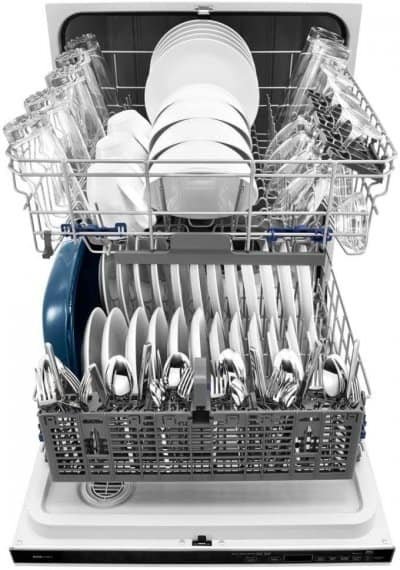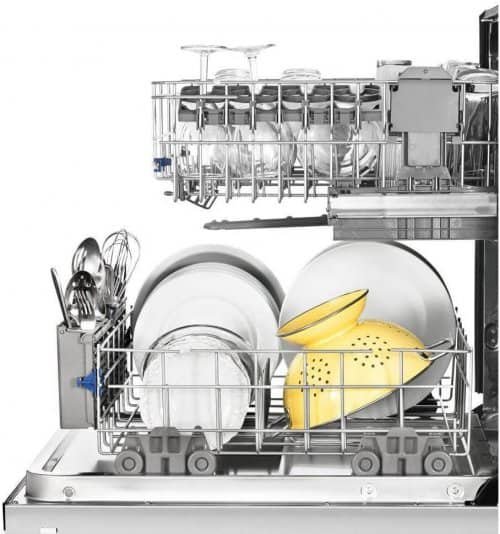Removing limescale from dishes in a dishwasher can be a tricky process. Over time, calcium deposits can build up and cause the dishwasher to become less effective at cleaning dishes. Fortunately, there are steps that you can take to effectively remove limescale from dishes in your dishwasher. In this article, we will discuss the best practices for removing limescale from dishes in a dishwasher, as well as provide tips on how to prevent further buildup.
Table of Contents
What is Limescale?
Limescale buildup in dishwashers is a common issue, caused by hard water containing high levels of calcium or magnesium. This mineral-rich water reacts with the metal components of the dishwasher and creates an uneven white coating on dishes and surfaces better known as limescale. Not only does this unsightly residue affect the appearance of your kitchen appliances, but it can also clog up filters and pipes in your dishwasher over time. To prevent limescale buildup in your dishwasher, regular maintenance is essential.
Regular cleaning using a combination of vinegar, baking soda, and citric acid will help to reduce limescale deposits from forming on surfaces inside the appliance such as elements, filters, and seals. You should also use salt to soften hard water when washing dishes and run the appliance on a hot cycle regularly for maximum effectiveness.
Causes of Limescale
Limescale is a crystalline substance composed of calcium carbonate that forms in hard water areas. It has been increasingly causing an issue for many households, as it causes cloudy dishes and white residues on showerheads. There are several causes of limescale build-up, including hard water mineral deposits, high temperatures during dishwashing cycles, and calcium present in the water itself.
To prevent limescale from occurring in your dishes or dishwasher, one should focus on reducing the amount of minerals found in the water. For instance, using filtered or softened water for dishwashing can help reduce limescale. Additionally, another way to address this issue is by running a vinegar cycle periodically through your dishwasher to neutralize minerals and break down salts in aggressive detergents that could cause limescale buildup.

Preventative Measures
Preventative measures are essential for keeping our everyday items in top condition. One of the most common preventative measures relates to household appliances, such as dishwashers. A common problem that can arise with dishwashers is the build-up of limescale on dishes. Thankfully, there are some relatively easy steps one can take in order to minimise this build-up and prolong the life of their appliance.
One useful tip is to use a filter or mesh bag designed specifically for holding smaller items such as cutlery and utensils when loading a dishwasher. This helps protect them from coming into contact with other dishes during certain cycles and reduces the risk of scratches which may encourage limescale formation over time. Additionally, regularly using a suitable detergent with descaling properties will help remove existing residue and limit any new build-up occurring in future washes.
Homemade Remedies
One of the most frustrating tasks when it comes to household chores is having to remove limescale from dishes in a dishwasher. Limescale build-up can prevent dishes from getting clean, leaving you with a pile of dirty plates and bowls that need to be cleaned all over again. Fortunately, there are some simple homemade remedies you can use to remove limescale from your dishwasher and get your dishes sparkling once again.
The simplest way to tackle limescale build-up is by using vinegar. Simply fill up two plastic cups with white distilled vinegar and place them in the top rack of your dishwasher before running an empty cycle on the highest setting. The acidity in the vinegar helps break down the minerals that cause limescale, allowing them to be easily washed away. This process not only removes existing limescale but also helps prevent future buildup as well.
Commercial Cleaners
Limescale can leave marks on the dishes that are hard to remove without a good cleaner. There are several commercial cleaners available for cleaning limescale from dishes in a dishwasher. Some of these include
- Lime-A-Way Dishwasher Cleaner
- CLR Calcium Lime Rust Remover
- Phosphate Magic Dish Soap Booster
- Citric Acid Multi-Purpose Descaler
These products work by dissolving the limescale deposits left behind after washing your dishes in the dishwasher.
Maintenance Tips
Removing limescale from dishes in a dishwasher can be a tricky task, but it doesn’t have to be. The most important thing is to take the time and go through the process step-by-step.
First, fill your sink with hot water and white vinegar in equal parts. This will help dissolve any limescale build-up on your dishes as you soak them for around 20 minutes.
Then, carefully place the dishes into your dishwasher and run a regular wash cycle on the hottest setting available, this will help remove remaining limescale deposits.
Once it’s complete, open up the dishwasher door to allow everything to air dry before putting them away! Lastly, if you notice that some areas are still covered in limescale residue, use an abrasive sponge or cloth to scrub away any remaining deposits until they disappear completely.
How to Remove Limescale from Dishes in Dishwasher?
Removing limescale from dishes in the dishwasher is a common problem faced by many homeowners. It can be solved with a few simple steps that, if followed correctly, will get rid of any limescale build-up.
Step 1:
Fill up the dishwasher detergent dispenser with white vinegar and set it to run on its highest temperature setting. This will help loosen any built-up limescale deposits in the machine’s filters and pipes.
Step 2:
Add baking soda to the bottom of your dishwasher and set it to run on its hottest cycle again. The combination of white vinegar and baking soda will create a powerful cleaning action which helps break down any stubborn grime or scale from your dishes.
Step 3:
Once your cycle has finished, inspect all of your dishes thoroughly for signs of limescale or other residues that may have been left behind by the process.
How do I get lime deposits out of a dishwasher?
One of the best ways to get lime deposits out of a dishwasher is to use a mixture of vinegar and baking soda. First, mix equal parts white vinegar and baking soda in a bowl. Then, pour the mixture into the bottom of your dishwasher and let it sit for about an hour. After an hour, run a normal cycle with hot water and no detergent. This should help to break down the lime deposits and remove them from your dishwasher.
If this method doesn’t work, you can also try using citric acid instead of vinegar. Mix one cup of citric acid with two cups of warm water and pour it into the bottom of your dishwasher. Let it sit for about an hour before running another cycle with hot water and no detergent.
If these methods don’t work, you may need to call a professional for help removing the lime deposits from your dishwasher.
How do I descale my dishwasher naturally?
Descale your dishwasher naturally by using a combination of vinegar and baking soda. Start by pouring one cup of white vinegar into the bottom of the dishwasher and running it on an empty cycle.
This will help to break down any built-up grime and residue. Once the cycle is complete, sprinkle a generous amount of baking soda onto the bottom of the dishwasher and run another empty cycle.
The baking soda will help to scrub away any remaining grime and scale buildup. After completing this process, you should notice that your dishwasher is much cleaner and free from limescale buildup.
What dissolves lime buildup?
Lime buildup, or calcium carbonate deposits, can be dissolved using a variety of methods. The most common method is to use an acidic cleaner such as vinegar or lemon juice. Simply mix the acid with water in a spray bottle and apply it to the affected area. Let it sit for 15-20 minutes before rinsing off with warm water.
Another option is to use a commercial lime remover product that contains phosphoric acid or hydrochloric acid. These products are usually more effective than natural acids but should be used with caution as they can cause skin irritation and damage surfaces if not used properly. Follow the directions on the packaging closely and wear protective gear when handling these chemicals.
Finally, you can also try using a pumice stone to scrub away lime buildup from surfaces like sinks and toilets. Be sure to use gentle pressure and short strokes so that you don’t damage the surface underneath.
What does limescale look like in a dishwasher?
Limescale in a dishwasher typically appears as a white, chalky residue that builds up on the interior surfaces of the appliance. The limescale is caused by hard water and minerals that accumulate over time.
It can appear as a thin film on the walls and racks of the dishwasher, or it may form thicker deposits in certain areas such as around the door seal or near faucets. In extreme cases, limescale can clog filters and pipes, resulting in poor cleaning performance and reduced efficiency.
To remove limescale from your dishwasher, you should start by wiping down the interior surfaces with a damp cloth to remove any loose debris. Then, use a descaling solution specifically designed for dishwashers to break down the limescale deposits. Follow the instructions on the product label and allow the solution to sit for at least 30 minutes before rinsing it off with clean water.
Conclusion:
It is important to maintain an effective cleaning routine for the dishes in your dishwasher. Along with regular washing and drying, it is wise to periodically clean the dishwasher itself. One of the most common issues that arise in this type of appliance is limescale build-up on dishes, which can occur due to hard water containing high levels of calcium and other minerals. Fortunately, there are several simple ways to remove limescale from dishes in a dishwasher.

